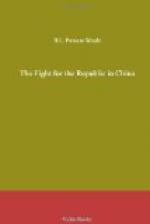These things, however, need not detain us. Not that Manchuria or the adjoining Mongolian plain is not important; not that the threads of destiny are not woven thickly there. For it is certain that the vast region immediately beyond the Great Wall of China is the Flanders of the Far East—and that the next inevitable war which will destroy China or make her something of a nation must be fought on that soil just as two other wars have been fought there during the past twenty years. But this does not belong to contemporary politics; it is possibly an affair of the Chinese army of 1925 or 1935. Some day China will fight for Manchuria if it is impossible to recover it in any other way,—nobody need doubt that. For Manchuria is absolutely Chinese—people must remember. No matter how far the town-dwelling Japanese may invade the country during the next two or three decades, no matter what large alien garrisons may be planted there, the Chinese must and will remain the dominant racial element, since their population which already numbers twenty-five millions is growing at the rate of half a million a year, and in a few decades will equal the population of a first-class European Power.
When we reach Group III we touch matters that are not only immediately vital but quite new in their type of audacity and which every one can to-day understand since they are politico-industrial. Group III, as it stands in the original text, is simply the plan for the conquest of the mineral wealth of the Yangtsze Valley which mainly centres round Hankow because the vast alluvial plains of the lower reaches of this greatest of rivers were once the floor of the Yellow Sea, the upper provinces of Hupeh, Hunan, Kiangsi being the region of prehistoric forests clothing the coasts, which once looked down upon the slowly-receding waste of waters, and which to-day contain all the coal and iron. Hitherto every one has always believed that the Yangtsze Valley was par excellence the British sphere in China; and every one has always thought that that belief was enough. It is true that political students, going carefully over all published documents, have ended their search by declaring that the matter certainly required further elucidation. To be precise, this so-called British sphere is not




